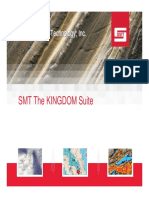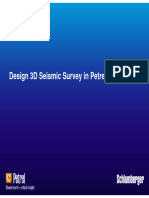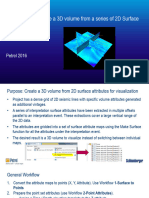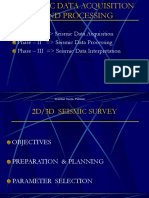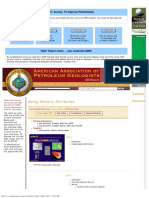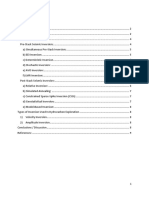Seismic Reflection Processing
Uploaded by
aprilliahrSeismic Reflection Processing
Uploaded by
aprilliahrEPS – 435 Geophysical Applications
Seismic Reflection Processing
Seismic reflection data are routinely acquired for multiple purposes such as
exploration, mining, or engineering problems.
The seismic data are generally acquired in shot-gathers, i.e. the data is
sorted (stored) by grouping data from all receivers for the same shot.
However, each receiver detects seismic energy emitted at the source from
different subsurface points:
From Reynolds, 1997
EPS435 – Fall 2008 Dr. Michael Riedel mriedel@eps.mcgill.ca EPSC-435-12-01
EPS – 435 Geophysical Applications
Seismic Reflection Processing
In order to image the same depth point
(referred to as Common-Depth-Point, or
CDP), sources and receivers are moved
across the area to be imaged. Each CDP now
receives energy from different angles of
incidence.
The originally shot-sorted seismic data now
need to be re-sorted into CDP-gathers
representing the same point in the
subsurface:
From Reynolds, 1997
EPS435 – Fall 2008 Dr. Michael Riedel mriedel@eps.mcgill.ca EPSC-435-12-02
EPS – 435 Geophysical Applications
Seismic Reflection Processing
The same idea seen before
holds for 3-D seismic data
acquisition, where a grid of
source- and receiver lines is
laid out across the survey
area, and traces representing
the same ‘bin’, or subsurface
rectangle area are grouped
together.
3-D seismic data acquisition
allows to fully represent
complex geologic structures
and rock-properties.
From Reynolds, 1997
EPS435 – Fall 2008 Dr. Michael Riedel mriedel@eps.mcgill.ca EPSC-435-12-03
EPS – 435 Geophysical Applications
Seismic Reflection Processing
In the following, several screen-shots from the demonstration in the class are
shown for several steps in the seismic data processing flow.
The data used are marine, multi-channel streamer data from offshore South
Korea, acquired in the Ulleung Basin in the East Sea (Sea of Japan).
The institute who shots the seismic data is the Korea Institute of Geosciences
and Mining and Materials (KIGAM).
The commercial processing software is GLOBE Claritas, from the Institute of
Nuclear Science in New Zealand.
EPS435 – Fall 2008 Dr. Michael Riedel mriedel@eps.mcgill.ca EPSC-435-12-04
EPS – 435 Geophysical Applications
Seismic Reflection Processing
A typical marine seismic data processing sequence consists of the following steps:
(1) Geometry definition (location of shot/receiver, CDP)
(2) Quality control, definition of frequency content of data
(3) Bandpass-filter (time-domain)
(4) Deconvolution (shaping of source-wavelet) [Æ not shown]
(5) Velocity analyses and normal move-out (NMO) correction
(6) Stack
(7) Migration
EPS435 – Fall 2008 Dr. Michael Riedel mriedel@eps.mcgill.ca EPSC-435-12-05
EPS – 435 Geophysical Applications
Seismic Reflection Processing
R
Display of first shot-gather in
seismic line. The direct
arrival (D) is clearly seen in
the upper left corner.
Reflections (R) arrive at ~2.9
M
s two-way time (TWT). A
multiple (M) is seen at ~ 6 s
TWT.
EPS435 – Fall 2008 Dr. Michael Riedel mriedel@eps.mcgill.ca EPSC-435-12-06
EPS – 435 Geophysical Applications
Seismic Reflection Processing
Example shot-
gather (split-
spread) from the
Rimouski-field trip
Platform-
reflection
EPS435 – Fall 2008 Dr. Michael Riedel mriedel@eps.mcgill.ca EPSC-435-12-07
EPS – 435 Geophysical Applications
Seismic Reflection Processing
Definition of frequency content of
data (first shot-gather, zoom).
EPS435 – Fall 2008 Dr. Michael Riedel mriedel@eps.mcgill.ca EPSC-435-12-08
EPS – 435 Geophysical Applications
Seismic Reflection Processing
Frequency-wave-number representation of same data set Æ used for
special design-filters (directionality)
EPS435 – Fall 2008 Dr. Michael Riedel mriedel@eps.mcgill.ca EPSC-435-12-09
EPS – 435 Geophysical Applications
Seismic Reflection Processing
Application of band-pass filter to remove high-frequency noise.
EPS435 – Fall 2008 Dr. Michael Riedel mriedel@eps.mcgill.ca EPSC-435-12-10
EPS – 435 Geophysical Applications
Seismic Reflection Processing
Velocity-analyses are carried out on an initial stack or brute-stack (left) with
constant-veloctiy gathers (middle) and semblance plots (right).
In this example a velocity of 1480 m/s flattens perfectly the top few layers near the seafloor, but deeper arrivals are still bending
upwards – velocity is higher. The semblance is a representation of the stack-power of an NMO-corrected gather. It is maximum if
the reflection hyperbola has been completely flattened.
EPS435 – Fall 2008 Dr. Michael Riedel mriedel@eps.mcgill.ca EPSC-435-12-11
EPS – 435 Geophysical Applications
Seismic Reflection Processing
Velocity-analyses are carried out on an initial stack or brute-stack (left) with
constant-veloctiy gathers (middle) and semblance plots (right).
In this example a velocity of 1520 m/s flattens perfectly a layers at 3.5 s TWT. The velocity is too high for the seafloor reflections,
thus they bend downward.
EPS435 – Fall 2008 Dr. Michael Riedel mriedel@eps.mcgill.ca EPSC-435-12-12
EPS – 435 Geophysical Applications
Seismic Reflection Processing
The seismic interpreter now defines a velocity-time function through the
points of maximum semblance, but avoiding spurious events.
EPS435 – Fall 2008 Dr. Michael Riedel mriedel@eps.mcgill.ca EPSC-435-12-13
EPS – 435 Geophysical Applications
Seismic Reflection Processing
With these velocities defined along
the entire profile at several
locations (in this example a set of
10 velocities would suffice), the
seismic data will all get NMO-
corrected (undo the hyperbola) and
the stacked to get a single trace
per CDP only. This forms then a
complete section showing an
acoustic image of the subsurface
lithology.
EPS435 – Fall 2008 Dr. Michael Riedel mriedel@eps.mcgill.ca EPSC-435-12-14
EPS – 435 Geophysical Applications
Seismic Reflection Processing
The last step in the processing is
MIGRATION. This step ensures
that the seismic energy recorded
in time, gets properly imaged into
depth by using the determined
velocities!
Note that compared to the stack,
all diffraction hyperbolas have
been removed by migrating the
energy to the correct subsurface
points from where they
originated.
EPS435 – Fall 2008 Dr. Michael Riedel mriedel@eps.mcgill.ca EPSC-435-12-15
EPS – 435 Geophysical Applications
Seismic Reflection Processing
3-D seismic data offer the
possibility to explore
subsurface in all dimensions
and define even complex
structures, such as the salt-
dome and basin to the right.
Slicing of data cube in inline –
crossline and time-slices.
From Yilmaz, 2001
EPS435 – Fall 2008 Dr. Michael Riedel mriedel@eps.mcgill.ca EPSC-435-12-16
EPS – 435 Geophysical Applications
Seismic Reflection Processing
3-D seismic data reveal new features, invisible by using 2D data only. A common attribute to
show seismic discontinuities (faults, channels) is coherency:
From Brown, 1999
EPS435 – Fall 2008 Dr. Michael Riedel mriedel@eps.mcgill.ca EPSC-435-12-17
EPS – 435 Geophysical Applications
Seismic Reflection Processing
From Brown, 1999
EPS435 – Fall 2008 Dr. Michael Riedel mriedel@eps.mcgill.ca EPSC-435-12-18
EPS – 435 Geophysical Applications
Seismic Reflection Processing
From Brown, 1999
EPS435 – Fall 2008 Dr. Michael Riedel mriedel@eps.mcgill.ca EPSC-435-12-19
EPS – 435 Geophysical Applications
Seismic Reflection Processing
From Brown, 1999
EPS435 – Fall 2008 Dr. Michael Riedel mriedel@eps.mcgill.ca EPSC-435-12-20
EPS – 435 Geophysical Applications
Seismic Reflection Processing
From Brown, 1999
EPS435 – Fall 2008 Dr. Michael Riedel mriedel@eps.mcgill.ca EPSC-435-12-21
EPS – 435 Geophysical Applications
Seismic Reflection Processing
Horizon-slice analyses
Offer 3D perspective of topography of
lithologic units and their relation to
structure features
From Yilmaz, 2001
EPS435 – Fall 2008 Dr. Michael Riedel mriedel@eps.mcgill.ca EPSC-435-12-22
EPS – 435 Geophysical Applications
Seismic Reflection Processing
4-D seismic data: repeated 3-D over same area.
Used to demonstrate production changes in subsurface (migration of oil, steam-
injection, CO2-sequestration).
EPS435 – Fall 2008 Dr. Michael Riedel mriedel@eps.mcgill.ca EPSC-435-12-23
EPS – 435 Geophysical Applications
Seismic Reflection Processing
Time-lapse seismic
data from (a) pre-
and (b)
postproduction times.
[MacLeod et al., 1999]
From Yilmaz, 2001
EPS435 – Fall 2008 Dr. Michael Riedel mriedel@eps.mcgill.ca EPSC-435-12-24
EPS – 435 Geophysical Applications
Seismic Reflection Processing
Time-lapse 4-D seismic data (time-slices) from 6
individual 3-D surveys taken at various times around a
steam-injection hole [from Lumley, 1995].
The red, near circular feature
corresponds to the spatial extent
of the injected steam.
From Yilmaz, 2001
EPS435 – Fall 2008 Dr. Michael Riedel mriedel@eps.mcgill.ca EPSC-435-12-25
You might also like
- AAPG Slide - Lecture-8 - Seismic Resolution - by Fred Schroeder.No ratings yetAAPG Slide - Lecture-8 - Seismic Resolution - by Fred Schroeder.7 pages
- TASK 2 - PMG517 Risk Management TemplateNo ratings yetTASK 2 - PMG517 Risk Management Template9 pages
- Atlas of Structural Geological Interpretation from Seismic ImagesFrom EverandAtlas of Structural Geological Interpretation from Seismic ImagesAchyuta Ayan MisraNo ratings yet
- 3-D Seismic and Horizontal Wells - SEISMIC INTERPRETATION 31No ratings yet3-D Seismic and Horizontal Wells - SEISMIC INTERPRETATION 315 pages
- RMS Seismic Attributes With RGB Color Blending Technique For Fault InterpretationNo ratings yetRMS Seismic Attributes With RGB Color Blending Technique For Fault Interpretation7 pages
- Seismic Reflection Data: What It Is, How It Can Be Used, & An Application at Elk Hills, CANo ratings yetSeismic Reflection Data: What It Is, How It Can Be Used, & An Application at Elk Hills, CA25 pages
- Lab 1 - Examine Seismic Data - QAB4083 - Seismic Data ProcessingNo ratings yetLab 1 - Examine Seismic Data - QAB4083 - Seismic Data Processing7 pages
- AAPG Slides - Lecture-11 - Stratigraphic Analysis - Interpretation - by Fred Schroeder.No ratings yetAAPG Slides - Lecture-11 - Stratigraphic Analysis - Interpretation - by Fred Schroeder.6 pages
- TG Structural Interpretation Ganjil 20-21No ratings yetTG Structural Interpretation Ganjil 20-2179 pages
- 3D Survey Design in Petrel - 6199334 - 03No ratings yet3D Survey Design in Petrel - 6199334 - 035 pages
- Software & Services: Qualify and Quantify Your ReservoirNo ratings yetSoftware & Services: Qualify and Quantify Your Reservoir13 pages
- 3D Volumes From 2D Attributes - 6964742 - 03No ratings yet3D Volumes From 2D Attributes - 6964742 - 039 pages
- VelocitymodelbuildinginPetrel Amir UTP CSI Nov 2019No ratings yetVelocitymodelbuildinginPetrel Amir UTP CSI Nov 2019139 pages
- Use of Seismic Attributes For Sediment Classificat PDFNo ratings yetUse of Seismic Attributes For Sediment Classificat PDF15 pages
- Depth Conversion of Time Interpretations Volume ModelsNo ratings yetDepth Conversion of Time Interpretations Volume Models53 pages
- Post Stack 3d Seismic Fractures CharacterizationNo ratings yetPost Stack 3d Seismic Fractures Characterization5 pages
- Phase - I Seismic Data Acquisition Phase - II Seismic Data Processing Phase - III Seismic Data InterpretationNo ratings yetPhase - I Seismic Data Acquisition Phase - II Seismic Data Processing Phase - III Seismic Data Interpretation27 pages
- AAPG Slides - Lecture-13 - Using Seismic Attributes - by Fred SchroederNo ratings yetAAPG Slides - Lecture-13 - Using Seismic Attributes - by Fred Schroeder11 pages
- Exploration For Stratigraphic Trap - AAPG - ch21100% (2)Exploration For Stratigraphic Trap - AAPG - ch2168 pages
- Qualitative-Quantitative Seis Interp-TionNo ratings yetQualitative-Quantitative Seis Interp-Tion21 pages
- 2d 3d 4d Exploracion Sismica para Geologos CH Liner Conex - Mayo 1999No ratings yet2d 3d 4d Exploracion Sismica para Geologos CH Liner Conex - Mayo 1999388 pages
- Vertical Seismic Profiling (VSP) : Fig. 4.45 Areas To Consider100% (2)Vertical Seismic Profiling (VSP) : Fig. 4.45 Areas To Consider10 pages
- Tutorial: Good Practice in Well Ties: First Break October 2003No ratings yetTutorial: Good Practice in Well Ties: First Break October 200327 pages
- 2010 04 RECORDER Model Based Seismic Inversion0% (1)2010 04 RECORDER Model Based Seismic Inversion12 pages
- Geovariances WhitePaper TimeDepthConversion PDFNo ratings yetGeovariances WhitePaper TimeDepthConversion PDF11 pages
- Enhanced Delineation of Reservoir Compartmentalization From Advanced Pre and Post Stack Seismic Attribute AnalysisNo ratings yetEnhanced Delineation of Reservoir Compartmentalization From Advanced Pre and Post Stack Seismic Attribute Analysis10 pages
- New Methods IN Shallow Seismic Reflection: Zuhar Zahir Tuan HarithNo ratings yetNew Methods IN Shallow Seismic Reflection: Zuhar Zahir Tuan Harith336 pages
- Rock-Physics-Assisted Well-Tie Analysis For Structural Interpretation and Seismic Inversion100% (1)Rock-Physics-Assisted Well-Tie Analysis For Structural Interpretation and Seismic Inversion7 pages
- Application of Petrophysics in Seismic Interpretation: BY RAJDEEP BURAGOHAIN (R280308025) B.Tech (GSE)100% (1)Application of Petrophysics in Seismic Interpretation: BY RAJDEEP BURAGOHAIN (R280308025) B.Tech (GSE)11 pages
- Rivers and Floodplains: Forms, Processes, and Sedimentary RecordFrom EverandRivers and Floodplains: Forms, Processes, and Sedimentary RecordNo ratings yet
- Explanation Text: Generic Structure of The TextNo ratings yetExplanation Text: Generic Structure of The Text3 pages
- LSN - A New Methodology For Characterising The Effects of Liquefaction in Terms of Relative Land Damage SeverityNo ratings yetLSN - A New Methodology For Characterising The Effects of Liquefaction in Terms of Relative Land Damage Severity8 pages
- Download ebooks file Encyclopedia of solid earth geophysics 2nd Edition Harsh K. Gupta (Editor) all chapters100% (4)Download ebooks file Encyclopedia of solid earth geophysics 2nd Edition Harsh K. Gupta (Editor) all chapters50 pages
- Waffle Box Building Technology PhilippinesNo ratings yetWaffle Box Building Technology Philippines20 pages
- Correction To: On The Potential For Megathrust Earthquakes and Tsunamis Off The Southern Coast of West Java and Southeast Sumatra, IndonesiaNo ratings yetCorrection To: On The Potential For Megathrust Earthquakes and Tsunamis Off The Southern Coast of West Java and Southeast Sumatra, Indonesia2 pages
- 1404 - UBC Seismic Risk Assessment - Building Report - June 18-2012No ratings yet1404 - UBC Seismic Risk Assessment - Building Report - June 18-201265 pages
- Grade 10 June Exam Marking Guideline 2023-2No ratings yetGrade 10 June Exam Marking Guideline 2023-29 pages
- HUGHES - Cator and Cribbage Construction of Northern PakistanNo ratings yetHUGHES - Cator and Cribbage Construction of Northern Pakistan12 pages
- 4YBzi4v de Thi Hoc Sinh Gioi Lop 9 Mon Tieng AnhNo ratings yet4YBzi4v de Thi Hoc Sinh Gioi Lop 9 Mon Tieng Anh7 pages
- The Istanbul Earthquake of 1894 and Science in The Late Ottoman EmpireNo ratings yetThe Istanbul Earthquake of 1894 and Science in The Late Ottoman Empire17 pages
- AAPG Slide - Lecture-8 - Seismic Resolution - by Fred Schroeder.AAPG Slide - Lecture-8 - Seismic Resolution - by Fred Schroeder.
- Atlas of Structural Geological Interpretation from Seismic ImagesFrom EverandAtlas of Structural Geological Interpretation from Seismic Images
- Seabed Seismic Techniques: QC and Data Processing KeysFrom EverandSeabed Seismic Techniques: QC and Data Processing Keys
- 3-D Seismic and Horizontal Wells - SEISMIC INTERPRETATION 313-D Seismic and Horizontal Wells - SEISMIC INTERPRETATION 31
- RMS Seismic Attributes With RGB Color Blending Technique For Fault InterpretationRMS Seismic Attributes With RGB Color Blending Technique For Fault Interpretation
- Seismic Reflection Data: What It Is, How It Can Be Used, & An Application at Elk Hills, CASeismic Reflection Data: What It Is, How It Can Be Used, & An Application at Elk Hills, CA
- Lab 1 - Examine Seismic Data - QAB4083 - Seismic Data ProcessingLab 1 - Examine Seismic Data - QAB4083 - Seismic Data Processing
- AAPG Slides - Lecture-11 - Stratigraphic Analysis - Interpretation - by Fred Schroeder.AAPG Slides - Lecture-11 - Stratigraphic Analysis - Interpretation - by Fred Schroeder.
- Software & Services: Qualify and Quantify Your ReservoirSoftware & Services: Qualify and Quantify Your Reservoir
- VelocitymodelbuildinginPetrel Amir UTP CSI Nov 2019VelocitymodelbuildinginPetrel Amir UTP CSI Nov 2019
- Use of Seismic Attributes For Sediment Classificat PDFUse of Seismic Attributes For Sediment Classificat PDF
- Depth Conversion of Time Interpretations Volume ModelsDepth Conversion of Time Interpretations Volume Models
- Phase - I Seismic Data Acquisition Phase - II Seismic Data Processing Phase - III Seismic Data InterpretationPhase - I Seismic Data Acquisition Phase - II Seismic Data Processing Phase - III Seismic Data Interpretation
- AAPG Slides - Lecture-13 - Using Seismic Attributes - by Fred SchroederAAPG Slides - Lecture-13 - Using Seismic Attributes - by Fred Schroeder
- 2d 3d 4d Exploracion Sismica para Geologos CH Liner Conex - Mayo 19992d 3d 4d Exploracion Sismica para Geologos CH Liner Conex - Mayo 1999
- Vertical Seismic Profiling (VSP) : Fig. 4.45 Areas To ConsiderVertical Seismic Profiling (VSP) : Fig. 4.45 Areas To Consider
- Tutorial: Good Practice in Well Ties: First Break October 2003Tutorial: Good Practice in Well Ties: First Break October 2003
- Enhanced Delineation of Reservoir Compartmentalization From Advanced Pre and Post Stack Seismic Attribute AnalysisEnhanced Delineation of Reservoir Compartmentalization From Advanced Pre and Post Stack Seismic Attribute Analysis
- New Methods IN Shallow Seismic Reflection: Zuhar Zahir Tuan HarithNew Methods IN Shallow Seismic Reflection: Zuhar Zahir Tuan Harith
- Rock-Physics-Assisted Well-Tie Analysis For Structural Interpretation and Seismic InversionRock-Physics-Assisted Well-Tie Analysis For Structural Interpretation and Seismic Inversion
- Application of Petrophysics in Seismic Interpretation: BY RAJDEEP BURAGOHAIN (R280308025) B.Tech (GSE)Application of Petrophysics in Seismic Interpretation: BY RAJDEEP BURAGOHAIN (R280308025) B.Tech (GSE)
- Rivers and Floodplains: Forms, Processes, and Sedimentary RecordFrom EverandRivers and Floodplains: Forms, Processes, and Sedimentary Record
- LSN - A New Methodology For Characterising The Effects of Liquefaction in Terms of Relative Land Damage SeverityLSN - A New Methodology For Characterising The Effects of Liquefaction in Terms of Relative Land Damage Severity
- Download ebooks file Encyclopedia of solid earth geophysics 2nd Edition Harsh K. Gupta (Editor) all chaptersDownload ebooks file Encyclopedia of solid earth geophysics 2nd Edition Harsh K. Gupta (Editor) all chapters
- Correction To: On The Potential For Megathrust Earthquakes and Tsunamis Off The Southern Coast of West Java and Southeast Sumatra, IndonesiaCorrection To: On The Potential For Megathrust Earthquakes and Tsunamis Off The Southern Coast of West Java and Southeast Sumatra, Indonesia
- 1404 - UBC Seismic Risk Assessment - Building Report - June 18-20121404 - UBC Seismic Risk Assessment - Building Report - June 18-2012
- HUGHES - Cator and Cribbage Construction of Northern PakistanHUGHES - Cator and Cribbage Construction of Northern Pakistan
- The Istanbul Earthquake of 1894 and Science in The Late Ottoman EmpireThe Istanbul Earthquake of 1894 and Science in The Late Ottoman Empire









